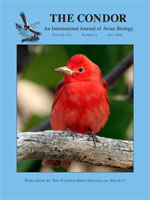Past studies of the marine diets of Surf Scoters (Melanitta perspicillata) and White-winged Scoters (M. fusca) have reported that they eat mostly bivalves, but deviations from well-established methods by most studies suggest that the importance of soft-bodied prey has been underestimated for both species. Methods needed to reduce bias in diet estimates include collecting birds that are feeding, immediately preserving gut contents, excluding gizzard contents, averaging food-item percentages across birds versus pooling gut contents for all birds, and using energy or ash-free dry mass versus wet mass values of foods. For Surf Scoters collected in northern Puget Sound, Washington during 2005–2006, adherence to the latter three methods alone resulted in the assessed bivalve component of diet declining by over half and a near doubling of soft-bodied prey (i.e., crustaceans, polychaetes). Diets of Surf Scoters differed among three heavily used bays with distinct benthic habitats, yet 67%–86% of the ash-free dry mass of esophagus contents from each bay was nonbivalve prey. A synthesis of previous and new diet data revealed differences between scoter species: relative to White-winged Scoters, Surf Scoters consume smaller bivalves, a smaller and more variable percentage of mollusk prey (including bivalves and gastropods), and a declining percentage of bivalves as winter progresses. Past diet studies for scoters may provide misleading guidelines to conservation efforts by implying that only standing stocks of bivalves require consideration when prioritizing critical foraging sites.
BioOne.org will be down briefly for maintenance on 14 May 2025 between 18:00-22:00 Pacific Time US. We apologize for any inconvenience.
How to translate text using browser tools
1 May 2008
Reevaluating Marine Diets of Surf and White-Winged Scoters: Interspecific Differences and the Importance of Soft-Bodied Prey
Eric M. Anderson,
James R. Lovvorn,
Matthew T. Wilson
ACCESS THE FULL ARTICLE

The Condor
Vol. 110 • No. 2
May 2008
Vol. 110 • No. 2
May 2008
bivalves
diet
Melanitta fusca
Melanitta perspicillata
Puget Sound
Surf Scoter
White-winged Scoter




